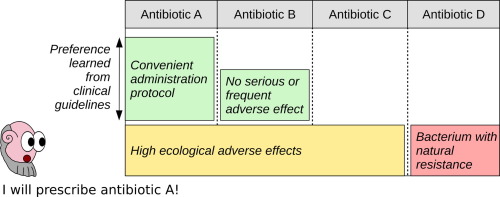Journal of Biomedical informatics ( IF 4.5 ) Pub Date : 2020-03-08 , DOI: 10.1016/j.jbi.2020.103407 Jean-Baptiste Lamy 1 , Karima Sedki 1 , Rosy Tsopra 2

|
The aim of eXplainable Artificial Intelligence (XAI) is to design intelligent systems that can explain their predictions or recommendations to humans. Such systems are particularly desirable for therapeutic decision support, because physicians need to understand rcommendations to have confidence in their application and to adapt them if required, e.g. in case of patient contraindication. We propose here an explainable and visual approach for decision support in antibiotic treatment, based on an ontology. There were three steps to our method. We first generated a tabular dataset from the ontology, containing features defined on various domains and n-ary features. A preference model was then learned from patient profiles, antibiotic features and expert recommendations found in clinical practice guidelines. This model made the implicit rationale of the expert explicit, including the way in which missing data was treated. We then visualized the preference model and its application to all antibiotics available on the market for a given clinical situation, using rainbow boxes, a recently developed technique for set visualization. The resulting preference model had an error rate of 3.5% on the learning data, and 5.2% on test data (10-fold validation). These findings suggest that our system can help physicians to prescribe antibiotics correctly, even for clinical situations not present in the guidelines (e.g. due to allergies or contraindications for the recommended treatment).
中文翻译:

通过学习和可视化抗生素治疗的正式本体论中的偏好获得可解释的决策支持
可扩展人工智能(XAI)的目的是设计可以向人类解释其预测或建议的智能系统。这样的系统对于治疗决策支持是特别理想的,因为医师需要理解建议以对它们的应用有信心,并且在需要时(例如在患者禁忌症的情况下)对其进行调整。我们在此基于本体提出一种可解释的,可视化的抗生素治疗决策支持方法。我们的方法分三个步骤。我们首先从本体生成表格数据集,其中包含在各个域和n上定义的特征-ary功能。然后从患者档案,抗生素特征和临床实践指南中发现的专家建议中学习偏好模型。该模型使专家的隐含理由变得清晰,包括处理缺失数据的方式。然后,我们使用彩虹盒(一种最近开发的可视化设置技术),将给定临床情况下的偏好模型及其在市场上所有抗生素的应用中可视化。最终的偏好模型在学习数据上的错误率为3.5%,在测试数据上的错误率为5.2%(10倍验证)。这些发现表明,即使对于指南中未提及的临床情况,我们的系统也可以帮助医生正确地开抗生素处方(例如 由于对推荐的治疗方法有过敏或禁忌症)。



























 京公网安备 11010802027423号
京公网安备 11010802027423号